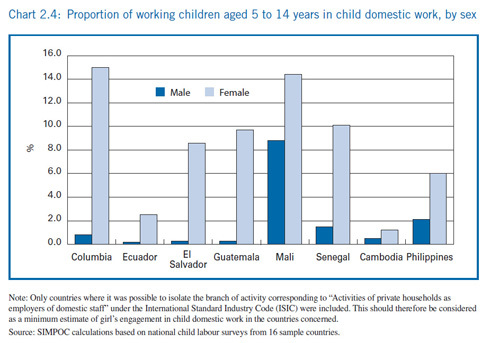Child Labor in Domestic Service by Gender

Annotation
The chart shows the proportion of male and female child laborers between the ages of 5 and 14 who are engaged in domestic work for third-party households. As the note on the chart indicates, only those countries in the data sample of 16 nations where domestic work could be distinguished from other kinds of work are featured in this chart. The sixteen sample countries included in the chart were based on nationally representative household surveys conducted between 1999 and 2007. The data comes from a study IPEC Statistical Information and Monitoring Programme on Child Labour (SIMPOC). (Geneva, ILO, 2009). The sample countries and the dates of data in the survey were Colombia (2001), Ecuador (2006), El Salvador (2001), Guatemala (2006), Burkina Faso (2006), Malawi (2002), Mali (2005), Senegal (2004), Cambodia (2001), Mongolia (2002), Philippines (2001), Sri Lanka (1999), Azerbaijan (2005), Kyrgyzstan (2007), Turkey (2006) and Ukraine (1999).
Domestic work includes housekeeping, such as: cleaning, cooking, washing, fetching supplies, and child care. Domestic work for an employer in a third-party household is considered by experts to be among the worst forms of child labor. Children, and especially girls, are often isolated in the household and invisible to others. Reports of abuse are frequent, but much abuse remains out of the public eye. Such children are often given up to other families because of their parents' inability to care for them. Children's earnings are sometimes given over to the person who contracted them through an agent or relative.
Data from the surveys show that while the vast majority of child domestic workers are girls, boys are also subjected to sexual abuse. The primary source text from Ecuador is typical of such stories gleaned by social workers and NGO's from work with children who escape or are removed from such situations.
The International Labour Organization (ILO) established the International Programme on the Elimination of Child Labour (IPEC) in 1992 with the goal of eliminating child labor. For statistical purposes, a child is considered to be involved in child labour under the following classification: (a) children 5-11 years of age who did at least one hour of economic activity or at least 28 hours of domestic work during the week preceding the survey, and (b) children 12-14 years of age who did at least 14 hours of economic activity or at least 28 hours domestic work during the week preceding the survey. Whether or not particular forms of "work" can be called "child labor" depends on the child's age, the type and hours of work performed, the conditions under which it is performed and the objectives pursued by individual countries.
IPEC classifies acceptable and unacceptable types of child labor. Acceptable work includes children helping parents around the home, earning pocket money after school and on holidays, and even helping in a family business. Such activity is viewed as beneficial to children's development and socialization. Unacceptable child labor, in contrast, is harmful to physical and mental development, to children's dignity, and "deprives children of their childhood." Child labor should be eliminated if it is mentally, physically, socially or morally dangerous and harmful to children; if it interferes with their schooling by preventing them from attending school, obligates them to leave school prematurely, or requires excessively long and heavy work as to compromise children's ability to attend school or learn effectively.
Text
"When I was 5 years old I was found abandoned in a park (in Ambato, Ecuador). Then I lived at a home with other girls who didn't have parents. When I was 10, they sent us to work in homes as domestic workers. In the house where I worked, the woman was bad and hit me. Then they took me out of there and sent me to another place – the house of a family that was rich. There was an old man there, the woman's husband, and whenever I was alone he would touch me and want to do things to me. I told the social worker, but she didn't believe me. One of the family's neighbours also told her, and then she did believe me. She took me out of there but she sent me to a worse place to work. At that house, the 16-year-old son called me into his room and pushed me onto the bed. Twice he tried to rape me. I got away from him and ran away from the house and didn't go back to the home. I was about 14 years old. . ."
Credits
"World Day 2009: Give girls a chance: End child labour," International Labour Organization, http://www.ilo.org/ipec/Campaignandadvocacy/WDACL/WorldDay2009/lang--en/index.htm (accessed November 2, 2009). Annotated by Susan Douglass. Text from IPEC: Girl child labour in agriculture, domestic work and sexual exploitation: Rapid assessments on the cases of the Philippines, Ghana and Ecuador (Geneva, ILO, 2004), cited in "Give girls a chance: Tackling child labour, a key to the future," International Labour Office, p. 27. (accessed November 2, 2009). Annotated by Susan Douglass.